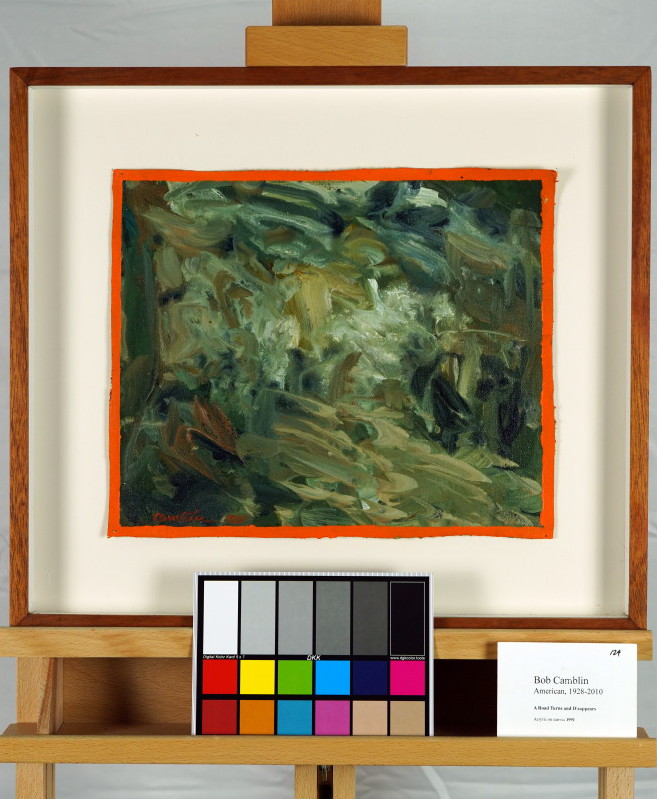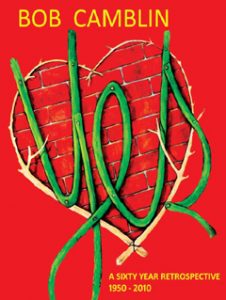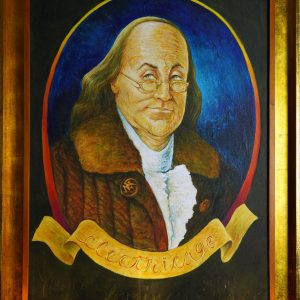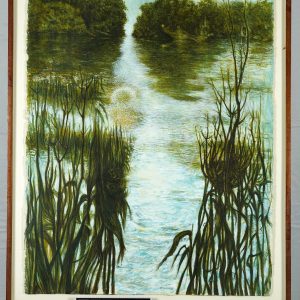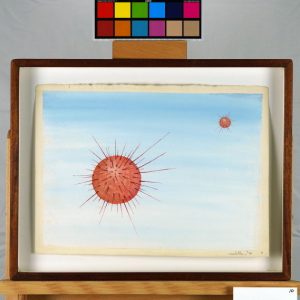Description
a road turns and disappears, 1991Acrylic on canvas
Signed
10.75 x 13 in. (image)
16.25 x 18.75 x 2 in. (frame)
original, includes certificate of authenticity from ArtTrust
The painting “A Road Turns and Disappears” employs an abstract approach, marked by expressive brushstrokes and swirling textures, evoking a sense of movement and energy. The bold orange border frames the inner chaos, almost creating a window into an internal, turbulent world. The painting reflects a dance between order and disorder, where the brushwork represents natural forces—perhaps wind, water, or fire—that are in constant flux.
In Zen, the concept of Mu (emptiness or the void) embraces the notion that all forms and distinctions are ultimately interconnected. This painting can be seen as an expression of that interconnectedness; it is neither confined to a specific form nor devoid of meaning. Instead, it invites the viewer to meditate on the formlessness within form and the transient nature of existence. The vibrant energy of the brushstrokes symbolizes the suchness of reality, a term in Zen used to denote things as they are, without the interference of subjective thought.
The I Ching, or Book of Changes, speaks to the natural cycles and transformations within the universe. This artwork embodies the principles of Hexagram 49, “Revolution” (Ge), which signifies the shedding of the old to make way for the new. The dynamic nature of the brushstrokes suggests a transformative process, where chaos leads to renewal. It evokes the idea of embracing change, even if it feels turbulent or unsettling, to reach a new state of balance.
When combining the perspectives of Zen and the I Ching, the painting emerges as a visual representation of the impermanence and ceaseless motion in life. It serves as a reminder that transformation is not just an external event but an internal journey of the self. The vivid orange border could be interpreted as a threshold, suggesting that we can step into this flow of change, allowing ourselves to be shaped by it. It embodies the balance between embracing the present moment (Zen) and navigating life’s constant changes (I Ching).
This piece aligns with the Expressionist tradition, where emotions and the artist’s internal landscape take precedence over representational accuracy. The use of impasto and gestural brushwork connects to the techniques seen in the works of artists like Willem de Kooning and Claude Monet, who sought to convey mood and movement through texture and color. The framing technique recalls methods used by Color Field painters who emphasized the power of a contained image, making this artwork a synthesis of both expressive and minimalist influences.
*Shipping cost will vary, please inquire at sales@camblingallery.com before purchasing.
Currently ships from Oregon, USA
Member of artnet? Apply for a discount! Inquire about intergallery and permanent loans for museums.
“a road turns and disappears” was featured in his Yes Retrospective
Reproductions of this drawing are available in multiple sizes!
Click here to use our high-resolution viewer!
This artwork is available with a non-fungible token to ensure traceability and transparency of provenance.
The royalty factor – Unlike traditional artworks, such as paintings, mosaics, statues, and the like, NFTs can be programmed to provide royalties to you every time the painting (and token) is sold and resold – for eternity. That mind-bending Camblin you sold could be worth millions one day and provide income for your great-great-great grandkids!
Anti-forgery – The central idea underpinning NFTs is that they are built on the blockchain, which is meant to offer advanced security. Think of it like an un-erasable and un-avoidable copyright.
Easy authentication – Another compelling aspect of NFT art and NFTs in general is the ability to quickly and easily authenticate items, as the record of ownership is scrupulously kept on the blockchain.
